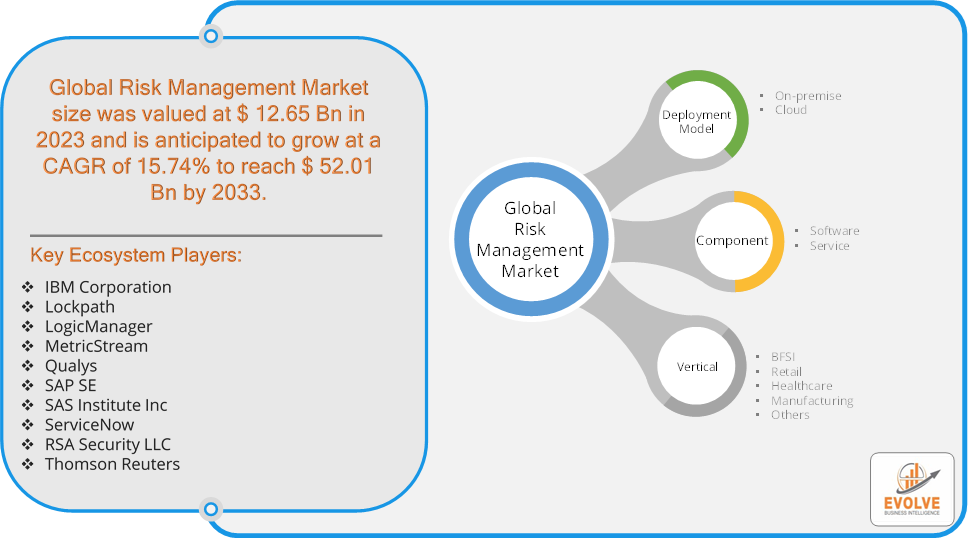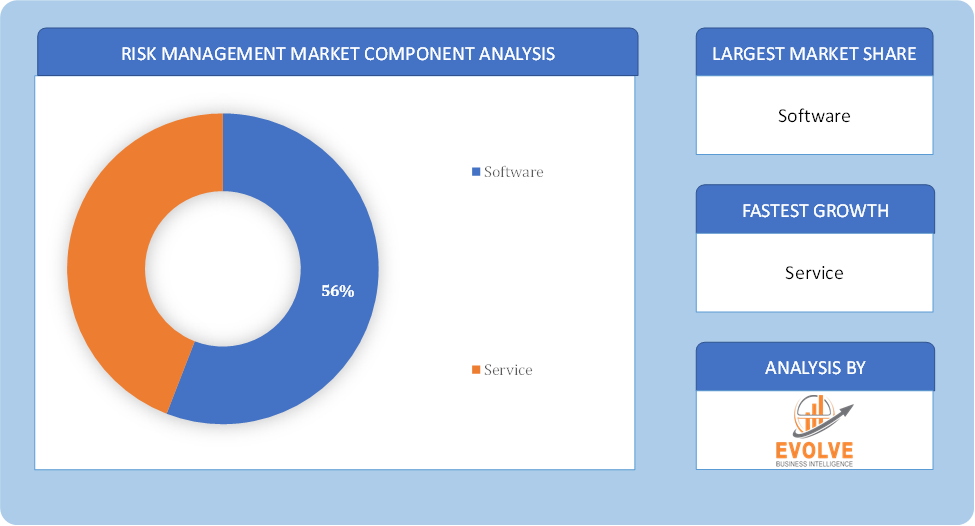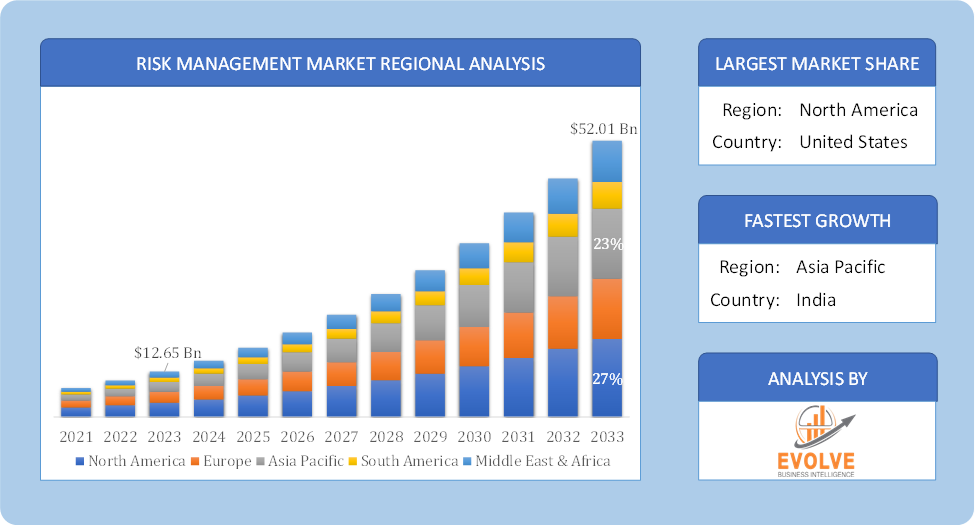Risk Management Market Analysis and Global Forecast 2023-2033
$ 1,390.00 – $ 5,520.00Price range: $ 1,390.00 through $ 5,520.00
Risk Management Market Research Report: Information By Component (Software, Service), By Deployment Model (On-premise, Cloud), By Industry Vertical (BFSI, Retail, Healthcare, Manufacturing, Others), and by Region — Forecast till 2033
Page: 162
Risk Management Market Overview
The Risk Management Market Size is expected to reach USD 52.01 Billion by 2033. The Risk Management Market industry size accounted for USD 12.65 Billion in 2023 and is expected to expand at a compound annual growth rate (CAGR) of 15.74% from 2023 to 2033. The Risk Management Market refers to the sector focused on identifying, assessing, and mitigating potential risks that could affect an organization’s operations, finances, reputation, or other aspects. It encompasses various tools, processes, and strategies employed by businesses to proactively manage risks, including financial risks, operational risks, regulatory compliance risks, and strategic risks. This market typically includes software solutions, consulting services, insurance products, and other risk management tools designed to help organizations predict, prevent, and respond to risks effectively.
Global Risk Management Market Synopsis

COVID-19 Impact Analysis
The COVID-19 pandemic had a significant impact on the Risk Management Market. The pandemic highlighted the importance of robust business continuity planning and disaster recovery strategies. Organizations intensified their efforts to assess and mitigate operational risks to ensure continuity in uncertain times. With remote work becoming the norm, cybersecurity risks escalated. This led to a greater demand for cybersecurity risk management solutions to protect sensitive data and systems from cyber threats. Rapid changes in regulations and compliance requirements due to the pandemic necessitated agile risk management frameworks to ensure adherence and mitigate compliance risks. The pandemic accelerated the adoption of digital risk management tools and platforms. Cloud-based risk management solutions, remote monitoring capabilities, and digital collaboration tools gained prominence to support decentralized work environments.
Risk Management Market Dynamics
The major factors that have impacted the growth of Risk Management Market are as follows:
Drivers:
Ø Growing Complexity of Risks
Businesses face a wide range of risks, including cybersecurity threats, financial uncertainties, supply chain disruptions, and operational challenges. The need to manage these complex risks effectively fuels the demand for comprehensive risk management solutions. Innovations in artificial intelligence (AI), machine learning, predictive analytics, and big data enable more sophisticated risk assessment and management capabilities. These technological advancements enhance the efficiency and effectiveness of risk management processes. Organizations are becoming more aware of the potential impact of risks on their operations, finances, reputation, and regulatory standing. This heightened awareness drives the adoption of proactive risk management practices.
Restraint:
- Perception of Cost and Budget Constraints
Implementing robust risk management solutions can involve significant upfront costs, including investment in technology, training, and ongoing maintenance. Budget constraints may limit the ability of organizations, particularly smaller ones, to adopt comprehensive risk management frameworks. Some organizations may view risk management primarily as a cost center rather than a strategic investment. This perception can lead to underinvestment in risk management initiatives and solutions, limiting their effectiveness in mitigating potential risks.
Opportunity:
⮚ Integration with Digital Transformation
As organizations undergo digital transformation journeys, there is an opportunity to integrate risk management into digital strategies seamlessly. This integration can enhance cybersecurity measures, data protection practices, and overall business resilience. With the increasing frequency and sophistication of cyber threats, there is a growing demand for cybersecurity risk management solutions. Solutions that offer threat detection, incident response, and vulnerability management capabilities are in high demand.
Risk Management Market Segment Overview

By Component
Based on Component, the market is segmented based on Software and Service. The software segment is driven by the increasing need for regulatory compliance across various industries. As governments and regulatory bodies across the globe continue to enforce stringent rules and standards, organizations are compelled to adopt software solutions that ensure adherence to these requirements. Software solutions offer the automation and real-time monitoring capabilities needed to manage and document compliance effectively.
By Deployment Model
Based on Deployment Model, the market segment has been divided into the On-premise and Cloud. The on-premises segment is driven by the increasing emphasis on security and data privacy concerns among organizations. With the rise in cyber threats and data breaches, companies are prioritizing the protection of their sensitive data. On-premises solutions provide businesses with greater control over their data and IT infrastructure, reducing the risks associated with third-party cloud providers.
By Vertical
Based on Vertical, the market segment has been divided into the BFSI, Retail, Healthcare, Manufacturing and Others. The BFSI segment is driven by the increasing adoption of technological advancements and digital transformation initiatives. As financial institutions strive to enhance customer experience and streamline operations, they are heavily investing in digital technologies such as artificial intelligence (AI), machine learning (ML), blockchain, and big data analytics. These technologies enable banks and financial service providers to offer personalized services, automate processes, and improve decision-making capabilities.
Global Risk Management Market Regional Analysis
Based on region, the global Risk Management Market has been divided into North America, Europe, Asia-Pacific, the Middle East & Africa, and Latin America. North America is projected to dominate the use of the Risk Management Market followed by the Asia-Pacific and Europe regions.

Risk Management North America Market
North America holds a dominant position in the Risk Management Market. North America dominates the global Risk Management Market due to stringent regulatory frameworks, particularly in sectors such as finance, healthcare, and IT. The region benefits from a high level of awareness about risk management practices and a strong emphasis on cybersecurity. The presence of key market players and technological advancements further drive market growth.
Risk Management Asia-Pacific Market
The Asia-Pacific region has indeed emerged as the fastest-growing market for the Risk Management Market industry. The Asia-Pacific region is experiencing rapid growth in the Risk Management Market, fueled by increasing regulatory scrutiny, economic expansion, and digital transformation initiatives. Countries like China, India, Japan, and Australia are investing in cybersecurity and compliance-focused risk management solutions. The region’s diverse industry landscape, including finance, manufacturing, and healthcare, presents significant growth opportunities.
Competitive Landscape
The global Risk Management Market is highly competitive, with numerous players offering a wide range of software solutions. The competitive landscape is characterized by the presence of established companies, as well as emerging startups and niche players. To increase their market position and attract a wide consumer base, the businesses are employing various strategies, such as product launches, and strategic alliances.
Prominent Players:
- IBM Corporation
- Lockpath
- LogicManager
- MetricStream
- Qualys
- SAP SE
- SAS Institute Inc
- ServiceNow
- RSA Security LLC
- Thomson Reuters
Key Development
In July 2022, Riskonnect, a leader in integrated risk management solutions, has acquired Castellan, a global provider of enterprise resilience software. This acquisition expands Riskonnect’s offerings, enhancing its ability to address various aspects of risk management.
In June 2022, SAS, a global analytics leader, has acquired Kamakura Corporation, a prominent risk management company based in Honolulu. This strategic acquisition aims to enhance SAS’s risk technology innovation and provide cutting-edge analytics solutions.
Scope of the Report
Global Risk Management Market, by Component
- Software
- Service
Global Risk Management Market, by Deployment Model
- On-premise
- Cloud
Global Risk Management Market, by Vertical
- BFSI
- Retail
- Healthcare
- Manufacturing
- Others
Global Risk Management Market, by Region
- North America
- US
- Canada
- Mexico
- Europe
- UK
- Germany
- France
- Italy
- Spain
- Benelux
- Nordic
- Rest of Europe
- Asia Pacific
- China
- Japan
- South Korea
- Indonesia
- Austalia
- Malaysia
- India
- Rest of Asia Pacific
- South America
- Brazil
- Argentina
- Rest of South America
- Middle East & Africa
- Saudi Arabia
- UAE
- Egypt
- South Africa
- Rest of Middle East & Africa
| Parameters | Indicators |
|---|---|
| Market Size | 2033: USD 52.01 Billion |
| CAGR (2023-2033) | 15.74% |
| Base year | 2022 |
| Forecast Period | 2023-2033 |
| Historical Data | 2021 (2017 to 2020 On Demand) |
| Report Coverage | Revenue Forecast, Competitive Landscape, Growth Factors, and Trends |
| Key Segmentations | Component, Deployment Model, Vertical |
| Geographies Covered | North America, Europe, Asia-Pacific, South America, Middle East, Africa |
| Key Vendors | IBM Corporation, Lockpath, LogicManager, MetricStream, Qualys, SAP SE, SAS Institute Inc, ServiceNow, RSA Security LLC and Thomson Reuters. |
| Key Market Opportunities | · Integration with Digital Transformation |
| Key Market Drivers | · Growing Complexity of Risks
· Advancements in Technology |
REPORT CONTENT BRIEF:
- High-level analysis of the current and future Risk Management Market trends and opportunities
- Detailed analysis of current market drivers, restraining factors, and opportunities in the future
- Risk Management Market historical market size for the year 2021, and forecast from 2023 to 2033
- Risk Management Market share analysis at each product level
- Competitor analysis with detailed insight into its product segment, Government & Defense strength, and strategies adopted.
- Identifies key strategies adopted including product launches and developments, mergers and acquisitions, joint ventures, collaborations, and partnerships as well as funding taken and investment done, among others.
- To identify and understand the various factors involved in the global Risk Management Market affected by the pandemic
- To provide a detailed insight into the major companies operating in the market. The profiling will include the Government & Defense health of the company’s past 2-3 years with segmental and regional revenue breakup, product offering, recent developments, SWOT analysis, and key strategies.
Frequently Asked Questions (FAQ)
What is the study period of this market?
The study period of the global Risk Management Market is 2021- 2033
What is the growth rate of the global Risk Management Market?
The global Risk Management Market is growing at a CAGR of 15.74% over the next 10 years
Which region has the highest growth rate in the market of Risk Management Market?
Asia Pacific is expected to register the highest CAGR during 2023-2033
Which region has the largest share of the global Risk Management Market?
North America holds the largest share in 2022
Who are the key players in the global Risk Management Market?
IBM Corporation, Lockpath, LogicManager, MetricStream, Qualys, SAP SE, SAS Institute Inc, ServiceNow, RSA Security LLC and Thomson Reuters. are the major companies operating in the market.
Do you offer Post Sale Support?
Yes, we offer 16 hours of analyst support to solve the queries
Do you sell particular sections of a report?
Yes, we provide regional as well as country-level reports. Other than this we also provide a sectional report. Please get in contact with our sales representatives.
Press Release

Global Pharmaceutical Manufacturing Market to Reach $1.38 Trillion by 2035 with 7.35% CAGR, New Research Shows

The Global Mammography Market Is Estimated To Record a CAGR of Around 10.29% During The Forecast Period

Glue Stick Market to Reach USD 2.35 Billion by 2034

Podiatry Service Market to Reach USD 11.88 Billion by 2034

Microfluidics Technology Market to Reach USD 32.58 Billion by 2034

Ferric Chloride Market to Reach USD 10.65 Billion by 2034

Family Practice EMR Software Market to Reach USD 21.52 Billion by 2034

Electric Hairbrush Market to Reach USD 15.95 Billion by 2034

Daily Bamboo Products Market to Reach USD 143.52 Billion by 2034

Cross-border E-commerce Logistics Market to Reach USD 112.65 Billion by 2034
Table of Content
CHAPTER 1. Executive Summary CHAPTER 2. Scope of the Study 2.1. Market Definition 2.2. Market Scope & Segmentation 2.2.1. Objective of Report CHAPTER 3. Evolve BI Methodology 3.1. Data Collection & Validation Approach 3.2. Market Size Estimation and Forecast CHAPTER 4. Exclusive Analysis 4.1. Market Opportunity Score 4.1.1. Component Segement – Market Opportunity Score 4.1.2. Deployment Model Segment – Market Opportunity Score 4.1.3. Vertical Segment – Market Opportunity Score 4.2. Key Market Influencing Indicators CHAPTER 5. Market Insights and Trends 5.1. Value Chain Analysis 5.1.1. Raw Material 5.1.2. Manufacturing Process 5.1.3. Distribution Channel 5.1.4. End User 5.2. Porter’s Five Forces Analysis 5.2.1. Bargaining Power of Buyers 5.2.2. Bargaining Power of Suppliers 5.2.3. Threat of New Entrant 5.2.4. Threat of Substitute 5.2.5. Industry Rivalry 5.3. COVID-19 Impact and Post COVID Scenario on Risk Management Market 5.3.1. Impact of COVID-19 5.3.2. Government Support and Industry Revival Policies 5.3.3. Measures Taken by Companies to Mitigate Negative Impact 5.3.4. Post COVID Trend CHAPTER 6. MArket Dynamics 6.1. Introduction 6.2. Drivers 6.2.1. Driver 1 6.2.2. Driver 2 6.2.3. Driver 3 6.3. Restraints 6.3.1. Restraint 1 6.3.2. Restraint 2 6.4. Opportunity 6.4.1. Opportunity 1 CHAPTER 7. Risk Management Market, By Component 7.1. Introduction 7.1.1. Software 7.1.2. Service CHAPTER 8. Risk Management Market, By Deployment Model 8.1. Introduction 8.1.1. On-premise 8.1.2. Cloud CHAPTER 9. Risk Management Market, By Vertical 9.1. Introduction 9.1.1. BFSI 9.1.2 Retail 9.1.3 Healthcare 9.1.4 Manufacturing 9.1.5 Others CHAPTER 10. Risk Management Market, By Region 10.1. Introduction 10.2. NORTH AMERICA 10.2.1. North America: Market Size and Forecast, By Country, 2023 – 2033 ($ Million) 10.2.2. North America: Market Size and Forecast, By Component, 2023 – 2033 ($ Million) 10.2.3. North America: Market Size and Forecast, By Deployment Model, 2023 – 2033 ($ Million) 10.2.4. North America: Market Size and Forecast, By Vertical, 2023 – 2033 ($ Million) 10.2.5. US 10.2.5.1. US: Market Size and Forecast, By Component, 2023 – 2033 ($ Million) 10.2.5.2. US: Market Size and Forecast, By Deployment Model, 2023 – 2033 ($ Million) 10.2.5.3. US: Market Size and Forecast, By Vertical, 2023 – 2033 ($ Million) 10.2.6. CANADA 10.2.6.1. Canada: Market Size and Forecast, By Component, 2023 – 2033 ($ Million) 10.2.6.2. Canada: Market Size and Forecast, By Deployment Model, 2023 – 2033 ($ Million) 10.2.6.3. Canada: Market Size and Forecast, By Vertical, 2023 – 2033 ($ Million) 10.2.7. MEXICO 10.2.7.1. Mexico: Market Size and Forecast, By Component, 2023 – 2033 ($ Million) 10.2.7.2. Mexico: Market Size and Forecast, By Deployment Model, 2023 – 2033 ($ Million) 10.2.7.3. Mexico: Market Size and Forecast, By Vertical, 2023 – 2033 ($ Million) 10.3. Europe 10.3.1. Europe: Market Size and Forecast, By Country, 2023 – 2033 ($ Million) 10.3.2. Europe: Market Size and Forecast, By Component, 2023 – 2033 ($ Million) 10.3.3. Europe: Market Size and Forecast, By Deployment Model, 2023 – 2033 ($ Million) 10.3.4. Europe: Market Size and Forecast, By Vertical, 2023 – 2033 ($ Million) 10.3.5. U.K. 10.3.5.1. U.K.: Market Size and Forecast, By Component, 2023 – 2033 ($ Million) 10.3.5.2. U.K.: Market Size and Forecast, By Deployment Model, 2023 – 2033 ($ Million) 10.3.5.3. U.K.: Market Size and Forecast, By Vertical, 2023 – 2033 ($ Million) 10.3.6. GERMANY 10.3.6.1. Germany: Market Size and Forecast, By Component, 2023 – 2033 ($ Million) 10.3.6.2. Germany: Market Size and Forecast, By Deployment Model, 2023 – 2033 ($ Million) 10.3.6.3. Germany: Market Size and Forecast, By Vertical, 2023 – 2033 ($ Million) 10.3.7. FRANCE 10.3.7.1. France: Market Size and Forecast, By Component, 2023 – 2033 ($ Million) 10.3.7.2. France: Market Size and Forecast, By Deployment Model, 2023 – 2033 ($ Million) 10.3.7.3. France: Market Size and Forecast, By Vertical, 2023 – 2033 ($ Million) 10.3.8. ITALY 10.3.8.1. Italy: Market Size and Forecast, By Component, 2023 – 2033 ($ Million) 10.3.8.2. Italy: Market Size and Forecast, By Deployment Model, 2023 – 2033 ($ Million) 10.3.8.3. Italy: Market Size and Forecast, By Vertical, 2023 – 2033 ($ Million) 10.3.9. SPAIN 10.3.9.1. Spain: Market Size and Forecast, By Component, 2023 – 2033 ($ Million) 10.3.9.2. Spain: Market Size and Forecast, By Deployment Model, 2023 – 2033 ($ Million) 10.3.9.3. Spain: Market Size and Forecast, By Vertical, 2023 – 2033 ($ Million) 10.3.10. BENELUX 10.3.10.1. BeNeLux: Market Size and Forecast, By Component, 2023 – 2033 ($ Million) 10.3.10.2. BeNeLux: Market Size and Forecast, By Deployment Model, 2023 – 2033 ($ Million) 10.3.10.3. BeNeLux: Market Size and Forecast, By Vertical, 2023 – 2033 ($ Million) 10.3.11. RUSSIA 10.3.11.1. Russia: Market Size and Forecast, By Component, 2023 – 2033 ($ Million) 10.3.11.2. Russia: Market Size and Forecast, By Deployment Model, 2023 – 2033 ($ Million) 10.3.11.3. Russia: Market Size and Forecast, By Vertical, 2023 – 2033 ($ Million) 10.3.12. REST OF EUROPE 10.3.12.1. Rest of Europe: Market Size and Forecast, By Component, 2023 – 2033 ($ Million) 10.3.12.2. Rest of Europe: Market Size and Forecast, By Deployment Model, 2023 – 2033 ($ Million) 10.3.12.3. Rest of Europe: Market Size and Forecast, By Vertical, 2023 – 2033 ($ Million) 10.4. Asia Pacific 10.4.1. Asia Pacific: Market Size and Forecast, By Country, 2023 – 2033 ($ Million) 10.4.2. Asia Pacific: Market Size and Forecast, By Component, 2023 – 2033 ($ Million) 10.4.3. Asia Pacific: Market Size and Forecast, By Deployment Model, 2023 – 2033 ($ Million) 10.4.4. Asia Pacific: Market Size and Forecast, By Vertical, 2023 – 2033 ($ Million) 10.4.5. CHINA 10.4.5.1. China: Market Size and Forecast, By Component, 2023 – 2033 ($ Million) 10.4.5.2. China: Market Size and Forecast, By Deployment Model, 2023 – 2033 ($ Million) 10.4.5.3. China: Market Size and Forecast, By Vertical, 2023 – 2033 ($ Million) 10.4.6. JAPAN 10.4.6.1. Japan: Market Size and Forecast, By Component, 2023 – 2033 ($ Million) 10.4.6.2. Japan: Market Size and Forecast, By Deployment Model, 2023 – 2033 ($ Million) 10.4.6.3. Japan: Market Size and Forecast, By Vertical, 2023 – 2033 ($ Million) 10.4.7. INDIA 10.4.7.1. India: Market Size and Forecast, By Component, 2023 – 2033 ($ Million) 10.4.7.2. India: Market Size and Forecast, By Deployment Model, 2023 – 2033 ($ Million) 10.4.7.3. India: Market Size and Forecast, By Vertical, 2023 – 2033 ($ Million) 10.4.8. SOUTH KOREA 10.4.8.1. South Korea: Market Size and Forecast, By Component, 2023 – 2033 ($ Million) 10.4.8.2. South Korea: Market Size and Forecast, By Deployment Model, 2023 – 2033 ($ Million) 10.4.8.3. South Korea: Market Size and Forecast, By Vertical, 2023 – 2033 ($ Million) 10.4.9. THAILAND 10.4.9.1. Thailand: Market Size and Forecast, By Component, 2023 – 2033 ($ Million) 10.4.9.2. Thailand: Market Size and Forecast, By Deployment Model, 2023 – 2033 ($ Million) 10.4.9.3. Thailand: Market Size and Forecast, By Vertical, 2023 – 2033 ($ Million) 10.4.10. INDONESIA 10.4.10.1. Indonesia: Market Size and Forecast, By Component, 2023 – 2033 ($ Million) 10.4.10.2. Indonesia: Market Size and Forecast, By Deployment Model, 2023 – 2033 ($ Million) 10.4.10.3. Indonesia: Market Size and Forecast, By Vertical, 2023 – 2033 ($ Million) 10.4.11. MALAYSIA 10.4.11.1. Malaysia: Market Size and Forecast, By Component, 2023 – 2033 ($ Million) 10.4.11.2. Malaysia: Market Size and Forecast, By Deployment Model, 2023 – 2033 ($ Million) 10.4.11.3. Malaysia: Market Size and Forecast, By Vertical, 2023 – 2033 ($ Million) 10.4.12. AUSTRALIA 10.4.12.1. Australia: Market Size and Forecast, By Component, 2023 – 2033 ($ Million) 10.4.12.2. Australia: Market Size and Forecast, By Deployment Model, 2023 – 2033 ($ Million) 10.4.12.3. Australia: Market Size and Forecast, By Vertical, 2023 – 2033 ($ Million) 10.4.13. REST FO ASIA PACIFIC 10.4.13.1. Rest fo Asia Pacific: Market Size and Forecast, By Component, 2023 – 2033 ($ Million) 10.4.13.2. Rest fo Asia Pacific: Market Size and Forecast, By Deployment Model, 2023 – 2033 ($ Million) 10.4.13.3. Rest fo Asia Pacific: Market Size and Forecast, By Vertical, 2023 – 2033 ($ Million) 10.5. South America 10.5.1. South America: Market Size and Forecast, By Country, 2023 – 2033 ($ Million) 10.5.2. South America: Market Size and Forecast, By Component, 2023 – 2033 ($ Million) 10.5.3. South America: Market Size and Forecast, By Deployment Model, 2023 – 2033 ($ Million) 10.5.4. South America: Market Size and Forecast, By Vertical, 2023 – 2033 ($ Million) 10.5.5. BRAZIL 10.5.5.1. Brazil: Market Size and Forecast, By Component, 2023 – 2033 ($ Million) 10.5.5.2. Brazil: Market Size and Forecast, By Deployment Model, 2023 – 2033 ($ Million) 10.5.5.3. Brazil: Market Size and Forecast, By Vertical, 2023 – 2033 ($ Million) 10.5.6. ARGENTINA 10.5.6.1. Argentina: Market Size and Forecast, By Component, 2023 – 2033 ($ Million) 10.5.6.2. Argentina: Market Size and Forecast, By Deployment Model, 2023 – 2033 ($ Million) 10.5.6.3. Argentina: Market Size and Forecast, By Vertical, 2023 – 2033 ($ Million) 10.5.7. REST OF SOUTH AMERICA 10.5.7.1. Rest of South America: Market Size and Forecast, By Component, 2023 – 2033 ($ Million) 10.5.7.2. Rest of South America: Market Size and Forecast, By Deployment Model, 2023 – 2033 ($ Million) 10.5.7.3. Rest of South America: Market Size and Forecast, By Vertical, 2023 – 2033 ($ Million) 10.6. Middle East & Africa 10.6.1. Middle East & Africa: Market Size and Forecast, By Country, 2023 – 2033 ($ Million) 10.6.2. Middle East & Africa: Market Size and Forecast, By Component, 2023 – 2033 ($ Million) 10.6.3. Middle East & Africa: Market Size and Forecast, By Deployment Model, 2023 – 2033 ($ Million) 10.6.4. Middle East & Africa: Market Size and Forecast, By Vertical, 2023 – 2033 ($ Million) 10.6.5. SAUDI ARABIA 10.6.5.1. Saudi Arabia: Market Size and Forecast, By Component, 2023 – 2033 ($ Million) 10.6.5.2. Saudi Arabia: Market Size and Forecast, By Deployment Model, 2023 – 2033 ($ Million) 10.6.5.3. Saudi Arabia: Market Size and Forecast, By Vertical, 2023 – 2033 ($ Million) 10.6.6. UAE 10.6.6.1. UAE: Market Size and Forecast, By Component, 2023 – 2033 ($ Million) 10.6.6.2. UAE: Market Size and Forecast, By Deployment Model, 2023 – 2033 ($ Million) 10.6.6.3. UAE: Market Size and Forecast, By Vertical, 2023 – 2033 ($ Million) 10.6.7. EGYPT 10.6.7.1. Egypt: Market Size and Forecast, By Component, 2023 – 2033 ($ Million) 10.6.7.2. Egypt: Market Size and Forecast, By Deployment Model, 2023 – 2033 ($ Million) 10.6.7.3. Egypt: Market Size and Forecast, By Vertical, 2023 – 2033 ($ Million) 10.6.8. SOUTH AFRICA 10.6.8.1. South Africa: Market Size and Forecast, By Component, 2023 – 2033 ($ Million) 10.6.8.2. South Africa: Market Size and Forecast, By Deployment Model, 2023 – 2033 ($ Million) 10.6.8.3. South Africa: Market Size and Forecast, By Vertical, 2023 – 2033 ($ Million) 10.6.9. REST OF MIDDLE EAST & AFRICA 10.6.9.1. Rest of Middle East & Africa: Market Size and Forecast, By Component, 2023 – 2033 ($ Million) 10.6.9.2. Rest of Middle East & Africa: Market Size and Forecast, By Deployment Model, 2023 – 2033 ($ Million) 10.6.9.3. Rest of Middle East & Africa: Market Size and Forecast, By Vertical, 2023 – 2033 ($ Million) CHAPTER 12. Competitive Landscape 12.1. Competitior Benchmarking 2023 12.2. Market Share Analysis 12.3. Key Developments Analysis By Top 5 Companies 12.4. Market Share Acquisition Strategies: Analysis of Key Approaches Employed by Top Players CHAPTER 13. Company Profiles 13.1. IBM Corporation 13.1.1. Hanon Systems 13.1.2. Financial Analysis 13.1.2.1. Business Segment Revenue, 2020, 2021, 2022, $ Million 13.1.2.2. Geographic Revenue Mix, 2022 (% Share) 13.1.3. Product Portfolio 13.1.4. Recent Development and Strategies Adopted 13.1.5. SWOT Analysis 13.2. Lockpath 13.3. LogicManager 13.4. MetricStream 13.5. Qualys 13.6. SAP SE 13.7. SAS Institute Inc 13.8. ServiceNow 13.9. RSA Security LLC 13.10. Thomson Reuters
Connect to Analyst
Research Methodology







